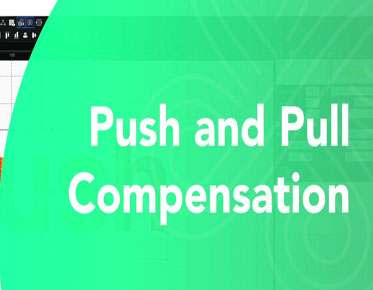The Ultimate Guide to Understanding The Push & Pull Technique for Digitizing Embroidery
It can be hard to grasp the concept of embroidery design, especially if you are new to embroidery. It can be very useful to know the various types of engines and how they are built. For most of the embroiderers, I've discovered that this has never been part of their training, and they don't even know the difference between the knitted and the woven. On the other hand, know the distinction between knitted and woven fabrics. The following content also has some reference value for Eagle digitizing.
We will look at three major types of cloth: woven, knitted, and French, as well as how they are influenced by the push-pull.
Woven fabrics are usually very stable
and don't stretch much. Some popular examples include denim, canvas (tote bags
or Carhart jackets), thin nylon trench coats, waffle-weave fabrics like
bathrobes, and linen fabrics like tablecloths and napkins. These types of
fabrics do not require as much tension compensation as other fabrics.
Knitted or loose knits require more compensation than wovens. Good examples of knitwear are t-shirts, polo shirts, sweaters, sweatshirts and lycra clothing. These fabrics all have varying degrees of stretch that must be compensated for in terms of weight and stretch. The more open or loose the knit, the more tension compensation needs to be applied than a more stable fabric. Terry cloth is another fabric that must be treated yourself. We will discuss this later in this article.
What is embroidery push and pull compensation?
When the needle goes down and penetrates into the fabric, this is called the penetration point of the stitch. When the top thread in the needle penetrates the fabric, it connects with the thread axis. It creates a pulling effect when two lines are connected. This pulling effect will be magnified if you have long stitches or stretchy fabrics. The longer the stitch, the more you will pull in. The same goes for if your fabric is soft and stretchy.
When this happens, you need to compensate by taking longer to sew. This is called embroidery tension compensation. When you create a design for a sewn denim shirt and a knitted golf shirt, you want the finished design to look the same. Not unless you add stitch length to compensate for the amount of bend or elasticity in the fabric. You'll find this very apparent when you're working with shapes; for example circles or squares.
Most fabrics require the addition of pull compensation to compensate for the pushing and pulling effect of sewing the design into the fabric. All types of stitches create a push-pull effect, but this effect is most pronounced when using satin paths or complex fill stitches and when sewing large areas. The larger the area, the more you can push and pull. Knitted fabrics are known for pulling in. The softer the fabric, the more you can create this push and pull effect.
A push or expansion area is the top or bottom of the open end (ie. letter I) of a segment or column. This is on the other side of the penetration point. You have to bring those areas in, shorten them. This is called push compensation. It doesn't matter whether you're dealing with letters or shapes. It also works with the angles of your shapes. The stitch length or number of pulls you add depends on the stretch of the fabric, the type or number of pads used or how wide the column of segments is. Pull Composite and Extension Points
If you find that the design you are currently using is not staying in register, you may want to try increasing the stitch length in the pull-in area. The thrust or extension that needs to be introduced into the area or segment has approximately the same measurements that you add for pull compensation.
Always save the profile design in the native software file to ensure you can adjust the push and pull of various fabrics. You want your finished embroidery to look the same on a denim shirt as it does on a polo shirt. They won't unless you add the right amount of pull compensation and padding to do the job.
Embroidered push-pull and French terry
Terrycloth is basically an animal in
its own right. Terry can be knit or woven and can range in weight from light to
heavy. Because of these different factors, the padding and pulls you add will
depend on the weight of the fabric and the size of your embroidery design or
monogram. You have to experiment with samples before coming up with a final
setup. Once you have that, you'll want to save these settings and keep using
them for your terry fabrics. Remember, all software packages are different, and
all embroidery machines are different, so there will always be adjustments.
Sometimes this means having to digitize the actual pull comp into your design
if you don't get the results you want or don't work with your machine. If you
are creating your own underlay, you must know the amount of tension
compensation to apply before creating the underlay.
I hope I helped you understand pull
composition better. I know this motif is huge and difficult to master, but if
you do a lot of experimentation and keep track of your setup, you will quickly
learn more about this huge motif and be able to create better looking
embroidery designs.


